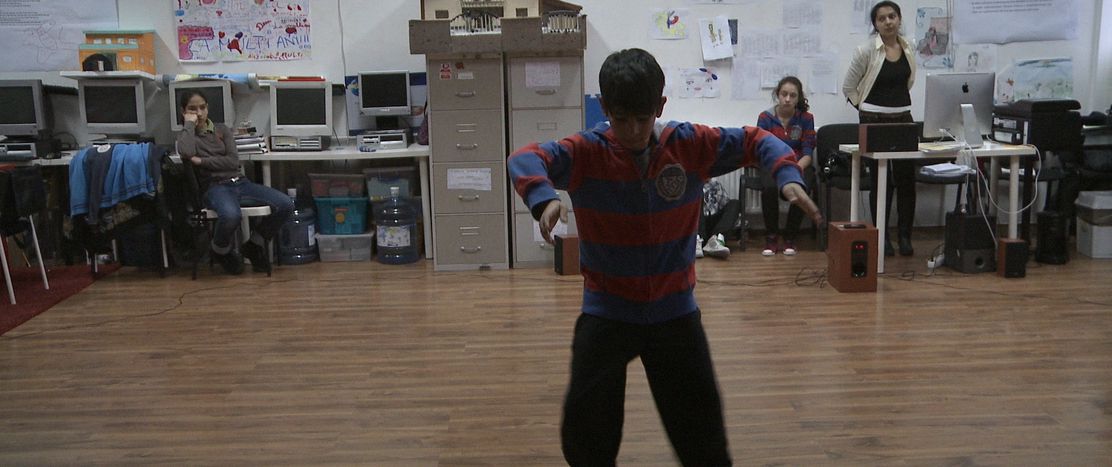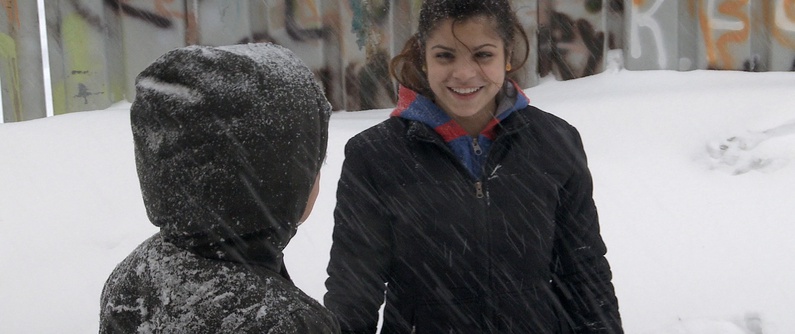
Toto and His Sisters: Between shadow and light
Published on
Translation by:
Monica BibersonAlexander Nanau's latest film, Toto and His Sisters, coming soon to French cinemas, proves to be one of the must-sees of the new year. A surprising documentary which follows a trio of exceptional protagonists: Roma children lacking everything apart from character and vitality.
In an impoverished suburb of Bucharest, Totonel aka Toto, a nine-year-old Roma boy, climbs up a wall to pick an apple. This short opening scene, catching a moment of mischievousness and pure innocence, will soon be swept away by a very different reality. At the same moment, Toto's two older sisters, Andrea and Ana, are giving a rundown apartment a good clean in preparation for their mother's return, who has been doing time for drug trafficking. Barely tidied up, the flat is quickly taken over by their uncles, heroin addicts, who make a mess and get stoned under the helpless gaze of the children whom they barely notice.
At the margin
Straddling the border between documentary and fiction, Alexander Nanau is firmly placed at the core of direct cinema - a type of documentary cinema born in the post-war years thanks to the lighter technology spreading at the time, which made possible a completely revolutionary approach. Small filming teams were able to move about more easily, following up from up close the course of events while at the same time remaining "invisible" around their chosen subjects. In the history of cinema this filming tradition - often openly activist in nature - has become a kind of methodology, a stance involving both a discreet and an omnipresent gaze.
 It is with this gaze that Nanau approached and mixed with the Roma community in Bucharest in search of a film commissioned by Strada Film. The German director decided to follow at length the daily life of these children who find themselves on the margin of society. It is by turning into a narrative that their lives take on exceptional features in the eyes of the viewers, who are disconcerted by a reality which is so moving, dynamic and changing that it seems staged. "Film yourselves for a year and you'll get a story," says Nanau.
It is with this gaze that Nanau approached and mixed with the Roma community in Bucharest in search of a film commissioned by Strada Film. The German director decided to follow at length the daily life of these children who find themselves on the margin of society. It is by turning into a narrative that their lives take on exceptional features in the eyes of the viewers, who are disconcerted by a reality which is so moving, dynamic and changing that it seems staged. "Film yourselves for a year and you'll get a story," says Nanau.
During his film, with its close-ups searching faces at length, the viewer gradually learns about the vulnerability as well as the strength of the lives unfolding on the screen. The director does not intervene (with the exception of his aesthetic choices and final editing), the narrative continuity stemming only from chance and the energy of these children seeking to escape their environment. Their emotions are not guided, rather, they come out naturally from Toto's and Andrea's awareness of the dramatic situation and their determination to live without their family.
In the middle of the chaos lies the sun
Alexander Nanau's direction transforms reality's raw material into a narrative of learning typical of a childhood drama. Toto goes through the gloomy daily life with force and determination, fighting against the world's darkness in the hope, despite everything, of living happily with his family. It is an unadulterated innocence against the harsh human reality. We only see society in the form of hooded police and judges whose faces remain off-camera. Invisible, it appears like a dehumanised, repressive force which marginalises the most disadvantaged by relegating them to an extreme poverty from which there is no escape. The lack of hope, symbolised by drugs, is a constant threat that makes individuals hollow and strangers to one another. The irresponsible uncles shoot up in front of the children like vampires threatening to contaminate their blood. Exhausted, Ana too ends up getting involved in drug trafficking and becomes addicted, reaching rock bottom and leaving Andrea and Toto alone.
The trailer for Toto and His Sisters
And yet, Nanau never dwells on the sordid side of life and shows glimpses of possible exits: a snow fight in a courtyard becomes a break from this chaotic daily life. During a hip-hop dance competition where Toto shines on stage, a bridge may start being built. In the middle of the chaos lies the sun - still shining though hidden in the dark.
How can one survive in life's disorder when utter poverty competes with the unravelling of family ties? How to move forward in spite of a family and society in dereliction of their duties? Finding one's place in the world comes at a price, that is the difficult observation of a powerful film which lies between shadow and light. It is a small miracle - similar to Ioanis Nuguet's Spartacus and Cassandra - in the middle of a world of minorities, particularly that of the Roma community, which is kept at bay and where permanent abandonment contrasts only with the both fragile and powerful love that can be given and received.
Toto and His Sisters draws a tender and cruel portrait of three siblings left to their own devices, abandoned by their family and society, who try to fight with all their might for a better future. Nanau tells us that reality, just like fiction, can be made up of stages, challenges, trials and reversals of situation. It can be a tragedy, then veer into a fairy tale, while sticking with its choice of "characters".
-
See: "Toto and His Sisters" by Alexander Nanau (out on 6 February 2015).
-
This article was written by La Parisienne de cafébabel. All rights reserved.
Translated from Toto et ses soeurs : entre les ombres et la lumière



